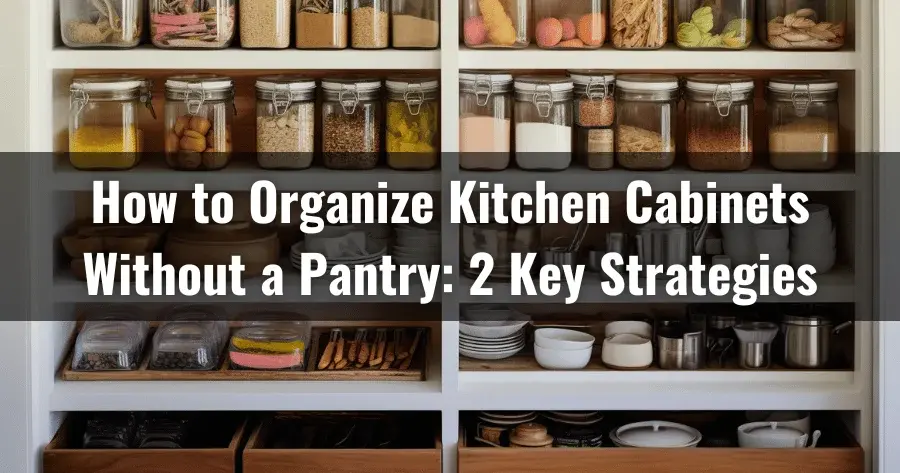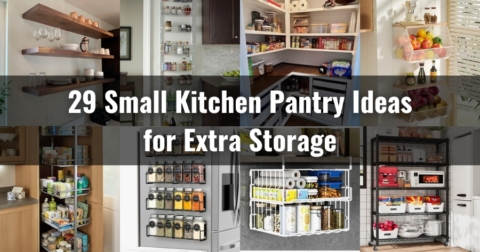Organizing your kitchen cabinets is the key to a well-functioning and efficient culinary haven, especially when you don’t have the luxury of a pantry. To organize your kitchen cabinets without a pantry, you’ll need a strategic approach that maximizes the available space and keeps your essentials easily accessible.
It begins with decluttering and defining your daily routine to ensure that the items you use most frequently are within arm’s reach.
Categorizing your kitchen items, from baking supplies to dinnerware and small appliances, helps create a logical and organized system.
We’ll take you through each step, providing practical advice and cabinet placement suggestions to ensure your kitchen remains a pleasant place to cook and work. So, let’s explore kitchen cabinet organization, where everything has its place.
How to Organize Kitchen Cabinets Without a Pantry: A Complete Guide

If you’re looking for ways to organize your kitchen cabinets without having a pantry, there are two key points to focus on:
- Declutter and define your daily routine
- Categorize your kitchen items
- Baking supplies
- Canned goods and non-perishables
- Cookware and bakeware
- Cooking utensils
- Dinnerware
- Spices and condiments
- Food storage containers
- Small appliances
- Food storage
Let’s examine in more detail these two factors for organizing kitchen cabinets without a pantry.
1. Declutter and Define Your Daily Routine
Decluttering is the first step to organizing kitchen cabinets when you don’t have a pantry. You may have items that are out of date, expired, or unused.
Take everything out of your cabinets, group related items, and create three categories: keep, donate/sell, and discard.
Keep items that you need and use regularly, like pots, pans, and other cookware. You can donate or sell items in good condition that you no longer need. Discard items that are old, damaged, or that you haven’t used in over six months.
2. Categorize Your Kitchen Items
After decluttering your kitchen cabinets, it’s time to categorize your kitchen items. Grouping similar items together makes finding what you’re looking for easier. Here are some ideas on how to categorize items and where they are best suited within your kitchen cabinets:
Baking Supplies
To keep your baking supplies organized, group items such as flour, sugar, baking powder, and baking soda together.
Consider separating ingredients from baking tools like mixing bowls, measuring cups, and utensils.
Our suggestion is that you keep your baking supplies in a lower cabinet near the area where you will be baking. This makes it convenient to access when you’re in the baking mood.
Canned Goods and Non-Perishables
Sort your canned goods by type, grouping similar items together for easy access. Categorize non-perishable items like pasta, rice, and beans by type and package size.
Reserve a lower cabinet for your canned goods as they tend to be heavier. This helps prevent accidents, particularly if you have children around. Consider using a pull-out shelf or stackable organizers to maximize space.
Dedicate a separate cabinet or shelf for non-perishables. It helps keep your kitchen looking organized by arranging them neatly by type and size.
Cookware and Bakeware
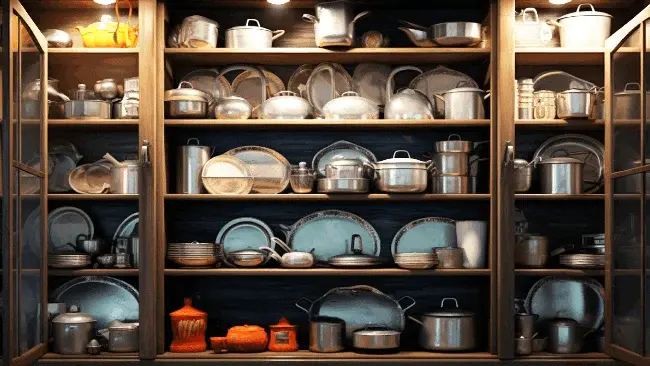
To sort your cookware and bakeware, separate them by type. This may include pots, pans, baking sheets, and casserole dishes.
Storing your cookware in a lower cabinet near the stove or oven for easy access can prevent accidents, as you don’t have to reach too high to get what you need.
Use racks or dividers to prevent stacking. If you have limited cabinet space, prioritize which cookware and bakeware you use the most.
For bakeware, consider a dedicated cabinet or drawer to keep your baking sheets, muffin tins, and cake pans organized.
Cooking Utensils
Categorize your cooking utensils by type, such as spatulas, ladles, and tongs. This makes it easy for you to reach for what you need without having to sift through everything in your drawer.
Use a drawer or a utensil organizer inside a cabinet to keep your cooking utensils neatly separated and easily accessible. You can also install hooks underneath your cabinets to hang your most used utensils.
Dinnerware
Grouping your dinnerware by type and function, such as plates, bowls, glasses, and mugs. This helps you easily find what you need when setting the table or entertaining guests.
Store your dinnerware in upper cabinets closer to the dining area. Use plate racks or stackable organizers to optimize vertical space. This not only looks neat and tidy, but it also prevents breakage.
Spices and Condiments
Organizing spices and condiments by type and separating herbs, spices, sauces, and oils can save you time and frustration when cooking.
Utilize a designated cabinet near your cooking area for spices and condiments. You can install a spice rack or pull-out shelves to maximize visibility and accessibility.
Using air-tight containers for your spices and condiments can help keep them fresh and prevent spills.
Labeling containers with their contents and expiration dates can help you keep track of what you have and what needs to be replenished.
Food Storage Containers
Sort your food storage containers according to their type and size. Match containers with their respective lids. Dedicate a lower cabinet or drawer for food storage containers.
Use dividers or stackable bins to keep them organized and easily accessible. Fold your plastic bags neatly to save space, or consider investing in glass containers for added durability.
Small Appliances
Group small appliances like blenders, toasters, and coffee makers together. Consider using a dedicated cabinet for small appliances. If space allows, you can also store them on rolling plant stands for easy access and mobility.
When not in use, keep your small appliances clean and dust-free. Place appliances you don’t use as often at the back of the cabinet to keep your frequently used appliances within easy reach.
Food Storage
Sort your food storage containers by type, plastic, glass, etc. Store food storage containers in a lower cabinet or drawer, using dividers or bins to keep them organized.
Avoid stacking food storage containers on top of each other as this can lead to clutter and frustration. Match containers with their corresponding lid to save time when packing leftovers.
Ideas to Get the Most Out of Your Kitchen Cabinet Organization Without a Pantry
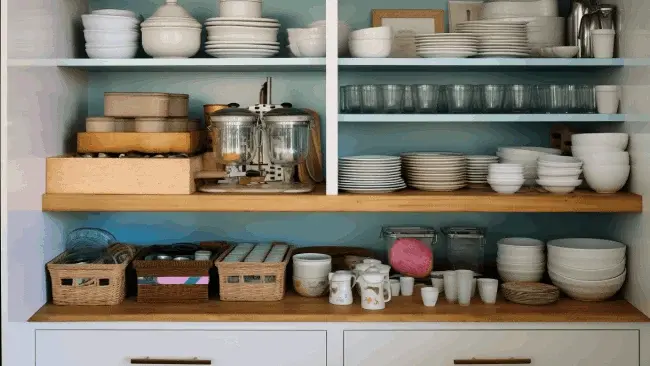
If you’re struggling with limited space in your kitchen cabinets and don’t have a pantry, here are our recommendations:
1. Utilize Space-Saving Tools
Space-saving tools and accessories can help maximize your limited storage space. Interior drawers and pull-outs are perfect for reaching items stored at the back of your cabinet with ease.
Utilizing clear containers on top shelves can keep smaller items, such as spices, baking supplies, or snacks, organized and easy to locate.
Raised cabinet racks are a great way to store dishes, lids, or baking sheets vertically, freeing up valuable space.
Turntables like Lazy Susans are ideal for corner cabinets where items at the back are hard to reach.
2. Implement Vertical Storage Solutions
Vertical storage solutions can be a game-changer when organizing your cabinets without a pantry.
Adding extra shelves inside your cabinets creates multiple storage levels, preventing items from piling up and making them more accessible.
Shelf risers are perfect for organizing dishes, plates, and bowls, allowing you to stack items while keeping them visible.
Installing hooks on the inside of cabinet doors or along the sides of cabinets can also help free up space by hanging mugs, utensils, or pot holders.
3. DIY Solutions
DIY ideas can spruce up your cabinet organization without breaking the bank.
Tension rods are a versatile option that can create instant shelves to separate items or even create a mini spice rack.
Labeling your containers, bins, and shelves can also significantly improve organization.
Clearly labeled containers make it easy to identify ingredients and kitchen tools quickly.
Frequently Asked Questions
We discovered that there are many questions people ask about arranging kitchen cabinets without a pantry. Here are a few you might find helpful.
What not to put in your kitchen cabinets?
To maintain a safe and organized kitchen, you should avoid storing items in your kitchen cabinets that could contaminate your food or compromise quality.
This includes bug killers and cleaning products, which should be stored separately to avoid accidental exposure.
Also, keep temperature-sensitive items such as medications and candles out of the area near the stove. Organize medicine in a cabinet with low temperature to prevent moisture damage.
Papers, non-essential electronics, and other clutter should also be kept out of kitchen cabinets to maintain an organized and efficient space.
Open food containers should be sealed in airtight containers to preserve freshness and prevent spills or contamination.
What is the most durable type of kitchen cabinet for organizing?
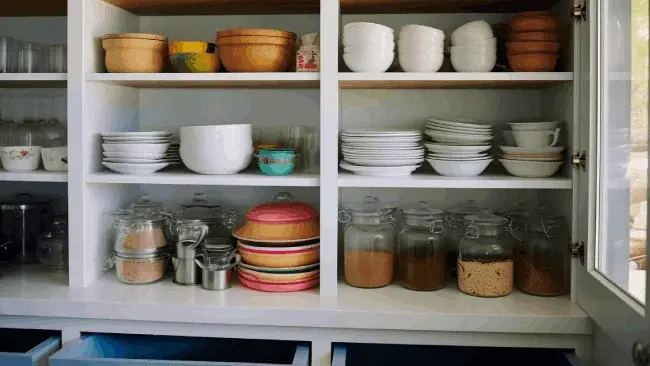
The most reliable type of kitchen cabinet for organizing your kitchen items is typically constructed from solid hardwood such as cherry or maple.
These cabinets are both aesthetically pleasing and renowned for their longevity. Although they may come with a hefty price tag, they are well worth the investment for those who seek to keep their kitchen organized for a long time.
It is important to note that there are cabinets made from plywood or MDF for a more budget-friendly option. However, they may not offer the same level of durability as solid hardwood cabinets.
Conclusion
You now possess the essential knowledge to transform your kitchen cabinets into a well-organized and efficient space, even without the luxury of a pantry.
By decluttering, categorizing, and utilizing the right storage solutions, you can make the most out of the available space and ensure that every pot, pan, and spice jar finds its perfect home.
Whether you’re a baking enthusiast, a cooking pro, or just want a clutter-free kitchen, these steps will help you organize your cabinets.
With a well-organized kitchen, meal preparation becomes a breeze, and you’ll have more time to savor the joy of cooking.


